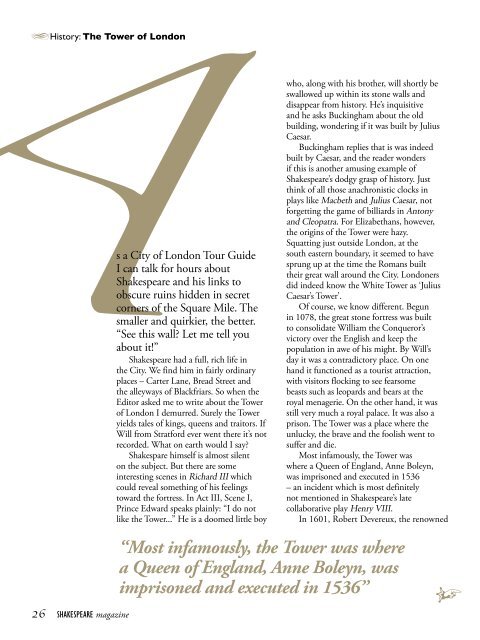Shakespeare Magazine 05
Issue 5 of Shakespeare Magazine celebrates the amazing Shakespeare documentary film Muse of Fire. We also investigate Shakespeare and the Tower of London, and take a trip to the American Shakespeare Center, while Shakespeare's Globe performs at the Inns of Court. Lois Leveen rethinks Romeo and Juliet with her novel Juliet's Nurse, while the Filter Theatre Company remixes Macbeth at the Tobacco Factory in Bristol. Plus! Station Eleven, the thrilling post-apocalyptic Shakespeare novel by Emily St. John Mandel.
Issue 5 of Shakespeare Magazine celebrates the amazing Shakespeare documentary film Muse of Fire. We also investigate Shakespeare and the Tower of London, and take a trip to the American Shakespeare Center, while Shakespeare's Globe performs at the Inns of Court. Lois Leveen rethinks Romeo and Juliet with her novel Juliet's Nurse, while the Filter Theatre Company remixes Macbeth at the Tobacco Factory in Bristol. Plus! Station Eleven, the thrilling post-apocalyptic Shakespeare novel by Emily St. John Mandel.
Create successful ePaper yourself
Turn your PDF publications into a flip-book with our unique Google optimized e-Paper software.
History: The Tower of London<br />
s a City of London Tour Guide<br />
I can talk for hours about<br />
<strong>Shakespeare</strong> and his links to<br />
obscure ruins hidden in secret<br />
corners of the Square Mile. The<br />
smaller and quirkier, the better.<br />
“See this wall? Let me tell you<br />
about it!”<br />
<strong>Shakespeare</strong> had a full, rich life in<br />
the City. We find him in fairly ordinary<br />
places – Carter Lane, Bread Street and<br />
the alleyways of Blackfriars. So when the<br />
Editor asked me to write about the Tower<br />
of London I demurred. Surely the Tower<br />
yields tales of kings, queens and traitors. If<br />
Will from Stratford ever went there it’s not<br />
recorded. What on earth would I say?<br />
Shakespare himself is almost silent<br />
on the subject. But there are some<br />
interesting scenes in Richard III which<br />
could reveal something of his feelings<br />
toward the fortress. In Act III, Scene I,<br />
Prince Edward speaks plainly: “I do not<br />
like the Tower...” He is a doomed little boy<br />
who, along with his brother, will shortly be<br />
swallowed up within its stone walls and<br />
disappear from history. He’s inquisitive<br />
and he asks Buckingham about the old<br />
building, wondering if it was built by Julius<br />
Caesar.<br />
Buckingham replies that is was indeed<br />
built by Caesar, and the reader wonders<br />
if this is another amusing example of<br />
<strong>Shakespeare</strong>’s dodgy grasp of history. Just<br />
think of all those anachronistic clocks in<br />
plays like Macbeth and Julius Caesar, not<br />
forgetting the game of billiards in Antony<br />
and Cleopatra. For Elizabethans, however,<br />
the origins of the Tower were hazy.<br />
Squatting just outside London, at the<br />
south eastern boundary, it seemed to have<br />
sprung up at the time the Romans built<br />
their great wall around the City. Londoners<br />
did indeed know the White Tower as ‘Julius<br />
Caesar’s Tower’.<br />
Of course, we know different. Begun<br />
in 1078, the great stone fortress was built<br />
to consolidate William the Conqueror’s<br />
victory over the English and keep the<br />
population in awe of his might. By Will’s<br />
day it was a contradictory place. On one<br />
hand it functioned as a tourist attraction,<br />
with visitors flocking to see fearsome<br />
beasts such as leopards and bears at the<br />
royal menagerie. On the other hand, it was<br />
still very much a royal palace. It was also a<br />
prison. The Tower was a place where the<br />
unlucky, the brave and the foolish went to<br />
suffer and die.<br />
Most infamously, the Tower was<br />
where a Queen of England, Anne Boleyn,<br />
was imprisoned and executed in 1536<br />
– an incident which is most definitely<br />
not mentioned in <strong>Shakespeare</strong>’s late<br />
collaborative play Henry VIII.<br />
In 1601, Robert Devereux, the renowned<br />
26 SHAKESPEARE magazine<br />
“Most infamously, the Tower was where<br />
a Queen of England, Anne Boleyn, was<br />
imprisoned and executed in 1536”

















